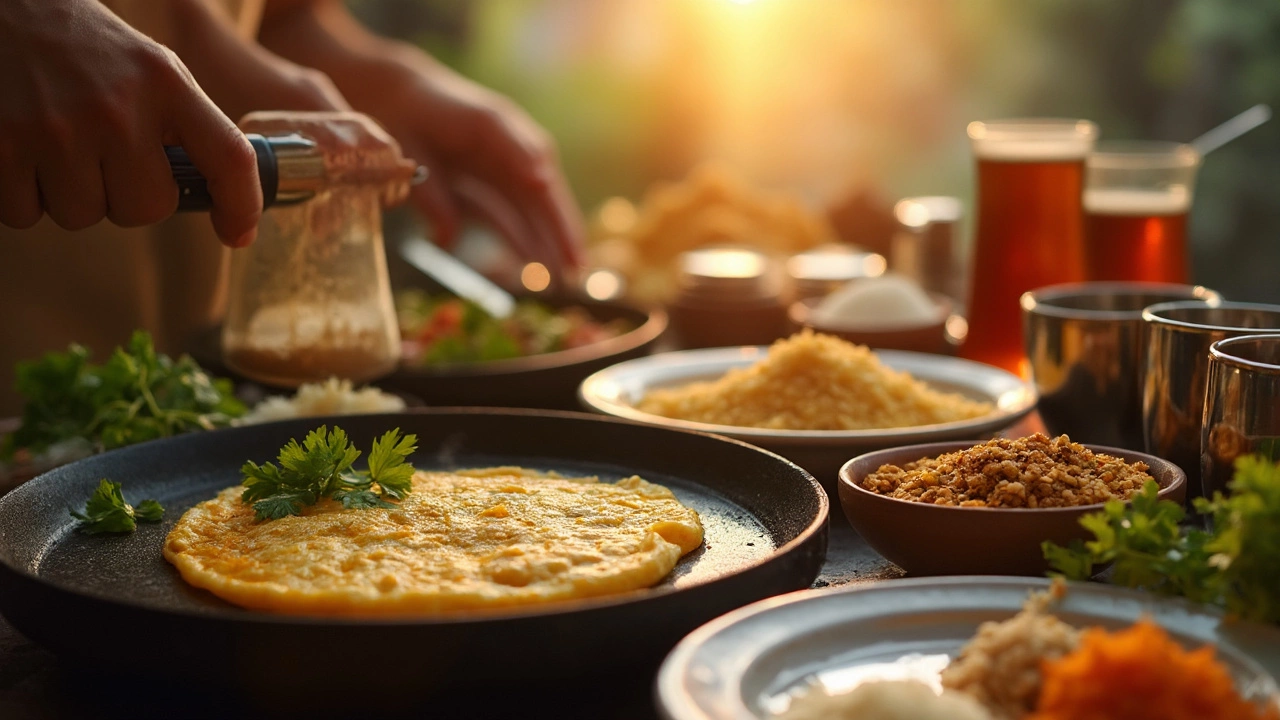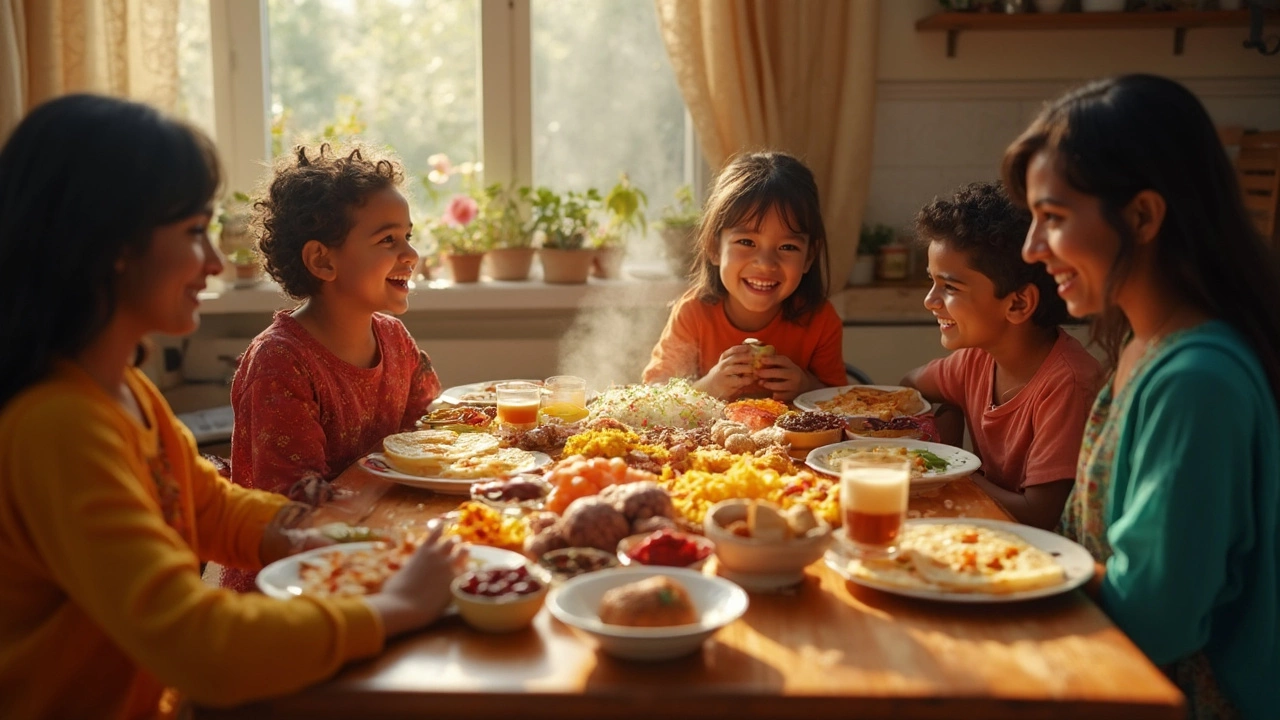16 May 2025
- 0 Comments
Ever wondered what’s actually the most eaten Indian breakfast? Step inside a typical home just as the sun peeks out—you’re most likely to find a steaming plate of poha or idli on the table before anything else. These dishes aren’t just crowd-pleasers because they’re delicious. They’re fast, filling, and fit right into the mad rush of weekday mornings.
It’s no accident people come back to these foods every day. They’re easy to prepare, require basic ingredients, and hit the sweet spot between being light and satisfying. And honestly, in a country where mornings are hectic and people need to get to work or school fast, easy wins.
- Why Breakfast Matters in India
- The King of Indian Breakfasts: Poha
- Idli Steals the South Indian Show
- Parathas and the North Indian Table
- Quick Tips to Speed Up These Dishes
- Surprising Regional Breakfast Hits
Why Breakfast Matters in India
If you skip breakfast in India, your mom or granny will probably scold you—and they're not wrong. Breakfast is seen as the real fuel for the day. People here usually eat between 7 am and 9 am, and studies show over 89% of Indians have something to eat in the morning, even if it's just a quick bite. The reason? Energy. School kids, daily wage workers, or tech professionals—everyone needs something to kickstart their day.
When it comes to routines, breakfast isn't just about food. It’s tied into daily life. In a survey done by the National Institute of Nutrition in 2023, breakfast was found to improve concentration, reduce crankiness, and even help people do better in school and work. That's why schools sometimes serve breakfast if families can't provide it.
Here's a quick look at why most families never skip breakfast, along with common quick breakfast habits:
- Most Indian breakfasts are cooked in less than 30 minutes.
- Families prefer warm, cooked foods over cold options.
- Regional favorites often revolve around most eaten Indian food like poha, idli, or paratha.
- Big cities see a rise in breakfast-on-the-go due to time crunches.
| Reason for Eating Breakfast | Percentage (Urban sample, 2023) |
|---|---|
| Energy Boost | 62% |
| Maintaining Routine | 21% |
| School/Work Requirement | 9% |
| Family Habit/Tradition | 8% |
When you look at the stats and habits, it’s obvious: breakfast isn’t just a meal, it’s almost a ritual. That’s what makes the search for quick, reliable breakfast food such a big deal for millions of people each morning.
The King of Indian Breakfasts: Poha
Poha is a true breakfast hero for millions of Indians, especially in Maharashtra, Madhya Pradesh, and Gujarat. Ask anyone from these regions what’s for breakfast and there’s a good chance they’ll say poha. It’s made from flattened rice—super handy if your mornings are rushed because poha cooks in under ten minutes. Flavor comes from mustard seeds, onions, green chilies, turmeric, peanuts, and sometimes potatoes or peas.
An important reason poha tops the most eaten Indian food list is flexibility. It suits all ages, can be made mild or spicy, and pairs perfectly with a hot cup of chai. Even people learning to cook start with poha because it’s forgiving—you can’t really mess it up.
Take a look at this table showing how often poha pops up in key Indian states, according to a 2024 food survey:
| State | Households (out of 100) Choosing Poha for Breakfast |
|---|---|
| Maharashtra | 73 |
| Madhya Pradesh | 62 |
| Gujarat | 54 |
| Chhattisgarh | 51 |
| Rest of India (average) | 27 |
If you want to try your hand at a quick and easy poha, here’s what you do:
- Rinse flattened rice quickly but don’t leave it soaking—it gets soggy fast.
- Heat a pan with a little oil and crackle mustard seeds.
- Sauté chopped onions and green chilies, toss in peanuts, and add cubed potatoes if you have time.
- Add turmeric, then mix in the drained poha. Salt and sugar to taste. Cover for two minutes, then squeeze some lemon before serving.
Poha is popular because you can add whatever you have—no tricky steps or exotic spices required. That’s why it sits at the top for quick breakfasts across India.
Idli Steals the South Indian Show
Nothing beats idli if you’re looking for a quick breakfast India can call its own. This soft and fluffy steamed rice cake is everywhere in South Indian homes and breakfast joints. Why? It’s easy on the stomach, super cheap to make, gluten-free, and ready in minutes if you have the batter.
Idlis are made from a mix of rice and urad dal that goes through a quick grind and then a long ferment. Next morning? You spoon it into molds, steam it, and it’s ready. Even the Indian Medical Association backs idli as “almost a complete food” because it’s light, has protein, and doesn’t call for any oil frying.
"Idli has been a staple for generations thanks to its simplicity, digestibility, and nutrition balance. It’s something you’ll find in every city, and many states twist it with their own side dishes." — Chandra Padmanabhan, author of ‘Dakshin: Vegetarian Cuisine from South India’
Want to see just how big idli’s reach is? Take a look:
| State | Breakfast Orders with Idli (%) |
|---|---|
| Tamil Nadu | 62 |
| Karnataka | 55 |
| Andhra Pradesh | 52 |
| Kerala | 44 |
These stats come from a 2024 report by Swiggy, showing just how popular idli is in online orders across the South.
And for busy mornings? You can buy ready-made idli batter or even instant mixes (these get you piping hot idlis in under 12 minutes). Top it off with sambar or coconut chutney, and breakfast is pretty much done. If you’re bored with plain idli, there are mini idlis, rava idlis, and stuffed masala idlis too. Seriously, it’s almost impossible not to find an idli you like.

Parathas and the North Indian Table
If you ask anyone from North India what a proper breakfast looks like, chances are they’ll say parathas without even thinking. These pan-fried flatbreads have been a favorite on North Indian breakfast tables for generations. The real magic is in the stuffings—like spiced potato (aloo), grated radish (mooli), or crumbled paneer—packed inside that crispy bread. Parathas are filling, easy to customize, and you can use leftover veggies or even just spice them up with a bit of salt and chili if you’re short on time.
What makes parathas top the most eaten Indian food list for quick breakfast? It’s not just the taste. They’re done in less than 20 minutes if you prep the dough ahead, and they go with almost anything: a dollop of butter, tangy pickle, creamy yogurt, or just straight off the skillet. Kids love them and adults swear by how long they keep you full.
| Popular Paratha Fillings | Prep Time (minutes) |
|---|---|
| Aloo (Potato) | 20 |
| Mooli (Radish) | 15 |
| Paneer (Cottage Cheese) | 18 |
| Plain (just with spices) | 10 |
There’s a reason people in Delhi, Punjab, and UP keep coming back to parathas, especially in winter. They use simple ingredients, so you don’t have to make any special trips to the store. Plus, you can make a big batch, freeze the rolled-out dough, and fry a fresh paratha in minutes on busy mornings.
Want to nail the paratha game without fuss? Here’s a tip: mix your dough with yogurt for softer breads, or add chopped coriander and chili straight into the dough for instant flavor. No time for side dishes? You can even wrap leftover sabzi in the paratha and call it a grab-and-go meal. That’s real everyday food for most families across North India.
Quick Tips to Speed Up These Dishes
If you're serious about getting breakfast on the table fast, these practical shortcuts can save you time every single day. For quick breakfast India eats like poha, idli, and parathas, it’s not about fancy gadgets. It’s about being a bit more organized and clever with your prep.
- Chop Ahead: Dice your onions, tomatoes, and chillies the night before. Store them in an airtight container in the fridge. This small move slashes your morning prep time in half for poha, upma, or aloo paratha fillings.
- Batch Soak or Ferment: Make idli or dosa batter in bulk on weekends. It stays good in the fridge for at least three days, so you can pour and steam without fussing in the morning rush.
- Ready-to-Use Poha: Rinse poha (flattened rice) and leave it to drain for a couple of minutes. If you keep all your spices and nuts pre-roasted in a jar, you won’t waste time measuring and roasting each morning.
- Use Leftovers Smartly: Extra sabzi or dal from dinner? Tuck it inside a paratha for a super quick stuffed version—no need to prep a whole new filling.
- Instant Options: For super busy schedules, try ready-to-cook batters or mixes. Brands like MTR and iD Fresh have pre-made, preservative-free options stocked in most Indian supermarkets now.
Quick breakfasts are all about tight planning and knowing where you can cut corners without losing taste or nutrition. Get a simple routine down, keep go-to ingredients stocked, and breakfast stress pretty much disappears.
Surprising Regional Breakfast Hits
It’s not just about poha or idli everywhere you go in India. Each region has its own breakfast that locals swear by, and some of these picks might totally surprise you. Let’s check out some standouts along with where they’re popular and what makes them tick.
| Region | Popular Breakfast | Main Ingredients |
|---|---|---|
| Mumbai & Gujarat | Vada Pav | Bread, spicy potato fritter, chutneys |
| Bengal | Luchi & Aloo Tarkari | Fried flour bread, potato curry |
| Kerala | Puttu & Kadala Curry | Steamed rice cake, black chickpea curry |
| Punjab | Chole Bhature | Spicy chickpeas, fried bread |
| Tamil Nadu | Pongal | Rice, lentils, ghee, spices |
| North-East | Pitha | Sticky rice, coconut, jaggery |
For folks in Mumbai, grabbing a vada pav on the go is basically a morning tradition. It’s affordable, spicy, and you can find it everywhere. In Kolkata, people love starting their day with luchi (like mini puris) and a simple potato curry—so classic that local bakeries still open early just for this combo.
If you wake up in Kerala, you’ll see puttu (cylinders of steamed rice and coconut) with a super flavorful black chickpea curry. The best part? It’s light but loaded with protein, and ready to eat right from the banana leaf it’s served on.
Punjabi breakfast tables stay hearty. Chole bhature isn’t just spicy and heavy—it’s the go-to treat for late weekend mornings, with lines outside popular spots even at 8 am. Meanwhile, in Tamil Nadu, pongal is everywhere, and it’s all about warmth, ghee, and subtle flavors. It gets served hot with a dollop of coconut chutney on the side.
The North-East? Here, people love pitha, which is a sweet or savory stuffed rice cake, often steamed or fried. It turns heads because it’s so different from most Indian breakfasts—think rice, not wheat, and coconut, not potatoes.
What’s cool to see? Regional breakfasts often use what’s in season and local. And if you look at eating habits across India, more than 80% of urban households tend to eat their own state or community’s special breakfast at least once or twice per week.
